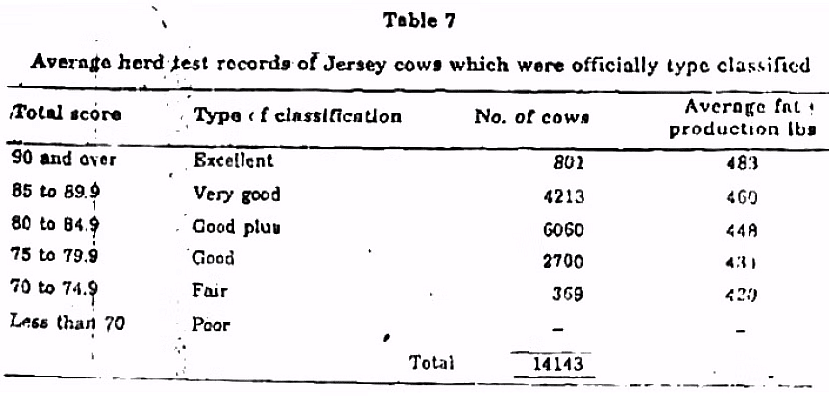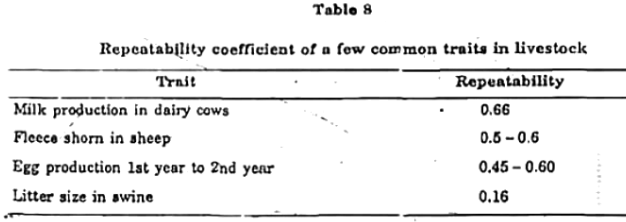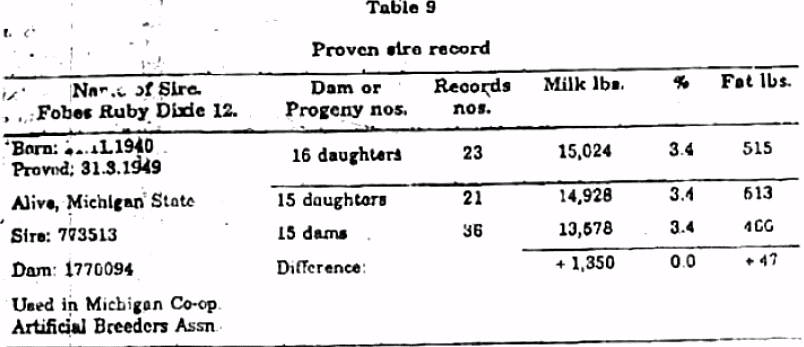Aids to Selection and their Relative Merits | Animal Husbandry & Veterinary Science Optional for UPSC PDF Download
Introduction
Individual selection involves choosing breeding stock based on the appearance (type) and performance of each individual. This method relies on the phenotype as the sole estimate of the genotype and breeding value. It is effective when the selected characteristics are expressed in both sexes and have high heritability. However, individual selection has limitations, especially when traits are expressed in only one sex or when heritability is low.
Type vs Performance
Individual selection should consider both type (outward formation) and performance (productivity). Type encompasses the external characteristics, such as color and conformation, typical of a breed. While breed type is important for purity, excessive focus on it can lead to discarding animals with above-average real usefulness. Balancing type and performance is crucial, considering the economic importance of specific traits.
Breed Type
Breed type refers to the external characteristics specific to a breed, outlined by breed associations. It serves as additional evidence of purity beyond pedigrees. However, overemphasizing breed type can be detrimental if economic significance is neglected. Attention to breed type should be proportional to market demand, as it holds value in certain contexts.
Ideal Draught and Dairy Types
For draught animals, the ideal market type includes a well-made, sound body with specific features such as a long, thick neck, high shoulders, wide deep body, good rump, and straight legs. Similarly, dairy-type animals should exhibit lean neck, shoulders, and thighs, with a deep, wide body, capacious mammary system, and high-quality udder. Market-type animals for meat production should be low set, blocky, and compact, emphasizing maximum development of loin, rear quarters, and rib muscling.
Significance of Outward Conformation in Selection
In the showring, beyond physical attributes, aesthetic value holds importance for the beauty and behavior of animals. Breeders prioritize outward conformation for two primary reasons: firstly, certain types have market value, leading to increased profitability, and secondly, in the absence of production records, selection based on type is believed to capture some level of productivity due to close correlation.
Correlation Studies between Type and Production
Studies, such as those conducted by Gowen in 1933, have examined correlations between conformation aspects and production records in dairy cattle and some meat animals. The table presents correlation coefficients between 7-day milk yield and various conformation characters. These correlations provide insights into the potential relationship between outward appearance and productivity.

Jersey Type Classification and Production Records
For a more suitable basis for studying correlation between type and production, data from Jersey type classification is considered. The following table summarizes data on Jersey cows, classifying them based on type and showcasing their 305-day milking performance. The average increase in fat production with each increase in type classification grade is highlighted.

Correlation between Type and Productivity in Livestock Selection
Beef Cattle
- In beef cattle, minimal correlation is observed between various body measurements and productivity, except for anatomical traits like fullness of round.
Swine and Sheep
- Swine exhibit little correlation between type and reproductive ability, while in sheep, discussions on type mainly revolve around the production or feeding qualities of lamb groups.
Summary of Findings
- A comprehensive analysis of the correlation between type and productivity in livestock reveals that extensive work has been done in dairy cattle and poultry, showing a low correlation between type and productivity.
- The significance of type in selection depends on market value, production correlation, and specific considerations related to the animal.
Factors Influencing Reliance on Type:
- In the absence of reliable production records.
- When selection occurs early in an animal's life, before production records are available.
- When records are available only for one sex, necessitating selection based on type.
- For animals like meat animals where production records come after the death of the animal.
- When productivity is challenging to measure comprehensively, such as in work and speed.
- When market demands a particular type for increased profitability.
- In cases where beauty is the primary consideration, such as in pet and fancy stock.
Production and Selection
- Domestic animals are primarily kept for converting feed into various products like milk, meat, eggs, wool, etc. Basing selection on production is justified, as studies indicate a positive correlation between return over feed cost and increased production.
Standardization of Production Records
- Accurate production records are essential, standardized to a uniform, comparable basis. In dairy cattle, records are commonly standardized to a 305-day, 6-year, 4% fat basis for easy comparison. In swine, correction factors are applied to equalize farrowing records to a gilt basis.
Averaging Records for Reduced Variations
- Using averages of many records helps reduce environmental variations in production, providing a more accurate representation of an animal's genetic potential.
Utilizing All Available Records
- To enhance accuracy, all available records, not just selected ones, should be considered. Omissions should only occur in cases of definitive circumstances like disease outbreaks.
Considering Health Setbacks
- Poor performance due to health setbacks should not be omitted from records, as it indicates a potential genetic concern for high production.
Correcting Incomplete Records
- Incomplete records should be meticulously corrected to ensure accurate assessment of an animal's performance and potential.
Decision-Making for Young Animals
- Economic considerations often necessitate decisions on keeping or culling young animals. Waiting until animals show at least one record, such as the first lactation in cows or the first litter in gilts, can enhance breeder accuracy in decision-making.
- Knowledge of the repeatability of records becomes crucial in predicting future performance.
Repeatability as a Predictive Measure
- Repeatability, measuring the ability of animals to reproduce their performance in successive years, is limited to characteristics observed more than once.
- For traits like milk yield in cows, high repeatability indicates reliability in predicting future performance based on the first record. However, low repeatability requires consideration of multiple records to reduce errors. Repeatability coefficients for various traits are outlined in the table below.

Consideration of Additional Factors
- Apart from production records, factors like constitution, longevity, disease resistance, and adaptation to climate should be considered in the overall production and selection process.
Pedigree and Its Utility in Selection
- Pedigree, a record of ancestors, gains biological significance from the expectation that offspring from outstanding parents inherit superior genetic traits. Pedigree selection becomes valuable when individual selection is impractical due to low heritability, absence of records, or when selecting male stock where the trait is not readily exhibited.
- Pedigree selection is especially useful when decisions need to be made for immature animals without production records or to complement individual selection.
Limitations of Pedigree Selection
- While useful in specific scenarios, pedigree selection has limitations, particularly in cases where accuracy in individual selection is challenging, such as low heritability of the trait or the absence of visible trait expression in male stock.
- It is a valuable supplement when selection must occur for immature animals without production records.
- The genetic makeup of parents is not entirely certain due to the complexity of genetic interactions like dominance and epistasis.
- Sampling nature of inheritance for heterozygous parents adds uncertainty about the genetic contribution of each parent to the individual offspring.
- Pedigrees often focus on selected individuals, providing biased information, and little about collateral relatives such as uncles and cousins.
- Pedigree selection can be enhanced by providing comprehensive information, both positive and negative, about ancestors, including collateral relatives.
- It should be used as a supplementary tool to individual selection, tipping the balance when individuals are closely matched on individual merits.
- Going beyond three generations in the pedigree may not offer significant advantages due to the halving process of chromosomes in each generation.
- The decision often arises regarding whether to choose a good individual with mediocre parents or a poor individual with excellent ancestors.
- Good individuals from poor parentage may possess a lucky combination of several genes, making them heterozygous for many desirable traits.
- Poor individuals from good parentage may lack a few critical genes for successful expression but can still inherit valuable genes.
Progeny Testing
Progeny test involves estimating an individual's heredity by studying its offspring. Individuality tells what an animal seems to be, pedigree tells what it ought to be, and progeny reveals what it is.
Uses of Progeny Test:
- Widely used in selecting bulls or roosters, especially when traits are expressed in only one sex, heritability is low, or when testing for recessive characters.
- Applicable when assessing characteristics that can only be measured post-mortem.
Conditions for Accurate Progeny Testing:
- The offspring being tested should form a representative group.
- The accuracy increases with a higher number of offspring in the test, minimizing errors in Mendelian sampling.
- Environmental factors affecting offspring must be closely studied, and allowances made for variations in conditions.
Limitations of Progeny Testing:
- Progeny testing often occurs late in an animal's life, making decisions about culling or using the animal for breeding already finalized.
- Environmental variations affecting offspring can limit the accuracy of progeny tests.
Example of Proved Sire Record:
- USDA's DHIA proved sire program uses records of daughters, considering the first 365 days of lactation period production.
- Records under or over 7 years are standardized to a six-year age basis using age correction factors.

FAQs on Aids to Selection and their Relative Merits - Animal Husbandry & Veterinary Science Optional for UPSC
| 1. What is the significance of outward conformation in livestock selection? |  |
| 2. How does pedigree contribute to selection in livestock breeding? |  |
| 3. What is the correlation between type and productivity in livestock selection? |  |
| 4. What is the role of progeny testing in livestock selection? |  |
| 5. What are some aids to selection in livestock breeding and their relative merits? |  |















